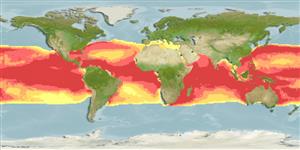ກຸ່ມປາກະດູກອ່ອນ (ເຊັ່ນ: ປາສະຫລາມ, ປາຜາໄລ) (sharks and rays) >
Carcharhiniformes (Ground sharks) >
Sphyrnidae (Hammerhead, bonnethead, or scoophead sharks)
Etymology: Sphyrna: Greek, sphyra = hammer (Ref. 45335).
ສະພາບແວດລ້ອມ / ສະພາບອາກາດ / ລະຍະ
ນິເວດວິທະຍາ
; ສັດທະເລ; ນ້ຳກ່ອຍ; ປາທີ່ມີການເຄື່ອນຍ້າຍໃນສະເພາະມາະຫາສະມຸດ (Ref. 51243); ລະດັບຄວາມເລິກ 1 - 300 m (Ref. 37816), usually 1 - 100 m (Ref. 89972). Subtropical, preferred ?; 45°N - 37°S, 180°W - 180°E
Circumglobal in coastal warm temperate and tropical seas (Ref. 13562). Western Atlantic: North Carolina, USA to Uruguay, including the Gulf of Mexico and Caribbean. Eastern Atlantic: Mediterranean and Morocco to Senegal. Indo-Pacific: throughout the Indian Ocean; Ryukyu Islands to New Caledonia and French Polynesia. Eastern Pacific: southern Baja California, Mexico to Peru. Highly migratory species, Annex I of the 1982 Convention on the Law of the Sea (Ref. 26139).
Length at first maturity / ຂະໜາດ / ນ້ຳໜັກ / Age
Maturity: Lm ?, range 250 - 300 cm
Max length : 610 cm TL ຕົວຜູ້/ບໍ່ມີເພດ; (Ref. 244); common length : 370 cm TL ຕົວຜູ້/ບໍ່ມີເພດ; (Ref. 13562); ນ້ຳໜັກສູງສຸດທີ່ເຄຍຈັດພີມມາ: 449.5 kg (Ref. 40637)
ຄີ (ໜາມ)ແຂງຢູ່ຫຼັງປາ (ທັງໝົດ): 0; ຄີຫຼັງຂອງປາ (ຄີອ່ອນ) (ທັງໝົດ): 0; ຄີ(ໜາມ) ແຂງຢູ່ຄີກົ້ນປາ
ກຸ່ມປາກະດູກແຂງ
ຄວາມຖີ່ຂອງກຸ່ມຖ່າຍທອດພັນ
ປາທີ່ມີການເຄື່ອນຍ້າຍຈາກທະເລໄປຫານ້ຳຈືດ ແລະນ້ຳຈືດຫາທະເລ
ປາທີ່ມີການເຄື່ອນຍ້າຍຈາກທະເລແລະໄປໄຂ່ຢູ່ນ້ຳຈືດ
ຄີກົ້ນຂອງປາ
ສັດທີ່ມີກະດູກສັນຫັຼງ
ການຖ່າຍທອດທາງກຳມະພັນຈາກພໍ່ແມ່ຫາລູກ 0; ຄີກົ້ນຂອງປາ: 0. A very large hammerhead also with a notch at the center of the head (Ref. 5578). Front margin of head gently curved in juveniles, becoming nearly straight in adults, with slight median notch (Ref. 26938). 1st dorsal fin very high and curved; 2nd dorsal and pelvic fins high and with deeply concave rear margins. Light grey or grey-brown above, white below; fins without conspicuous markings (Ref. 5578).
A coastal-pelagic, semi-oceanic shark, found close inshore and well offshore, over the continental shelves, island terraces, and in passes and lagoons (Ref. 244, 58302). Often bottom and reef associated at 1-80 m (Ref. 58302). Prefers to feed on stingrays and other batoids, groupers and sea catfishes, but also preys on other small bony fishes, crabs, squid, other sharks, rays, and lobsters (Ref. 244, 13562, 1602). A viviparous species, with 13-42 of about 56 to 70 cm young in a litter (Ref. 26938, 1602). Potentially dangerous to people (Ref. 13562) but only few, if any, of the attacks on people can be definitely attributed to it because of the apparent difficulty of distinguishing large hammerhead species involved in attacks (Ref. 244). Caught occasionally by target shark longline, demersal tangle net and tuna gillnet fisheries (Ref.58048). Meat utilized for human consumption (fresh, fresh-frozen, dried-salted, and smoked), liver oil for vitamins, fins for soup, hides for leather, and carcasses for fishmeal (Ref. 244). Its large fins, including the tail, sail-like first dorsal fin, are prized in the Oriental sharkfin trade (Ref. 47737).
Viviparous with a yolk sac placenta and 13-42 young in a litter (Ref. 244); 6-42 pups after gestation period of ~11 months (Ref.58048). Size at birth between 50 to 70 cm TL (Ref.58048, Ref. 13562).
Compagno, L.J.V., 1984. FAO Species Catalogue. Vol. 4. Sharks of the world. An annotated and illustrated catalogue of shark species known to date. Part 2 - Carcharhiniformes. FAO Fish. Synop. 125(4/2):251-655. Rome: FAO. (Ref. 244)
IUCN Red List Status (Ref. 115185)
Human uses
ການປະມົງ: ເປັນສີນຄ້າ
ຂໍ້ມູນຕື່ມອີກ
ເອກະສານອ້າງອີງການລ້ຽງສັດນ້ຳຂໍ້ມູນການລ້ຽງສັດນ້ຳສາຍພັນກຳມະພັນຄວາມຖີ່ຂອງກຸ່ມຖ່າຍທອດພັນການຖ່າຍທອດທາງກຳມະພັນຈາກພໍ່ແມ່ຫາລູກພະຍາດການປຸງແຕ່ງMass conversion
ເຄື່ອງມື
Special reports
Download XML
ແຫຼ່ງອີນເຕີເນັດ
